There have been a number of proposals to invest the Social Security surplus in the financial markets. Some proposals call for the government to do the investing. Others would have workers deposit part of their payroll tax payments in individual accounts that would be invested in assets, such as stocks and bonds. Are such investments inherently risky?
The returns on both stocks and bonds fluctuate widely – and at times wildly – from day to day and even from year to year. However, over longer investment periods this volatility is dramatically reduced – often to a few percentage points. Over the past 128 years:
- The annual returns on stocks range from a worst-year drop of 35 percent to a best-year increase of 47 percent.
- However, over investment periods of 35 years, the return on stocks ranges from a worst-period low of 2.7 percent to a high of 9.5 percent.
- The return on bonds ranges from a one-year low of -10.8 percent to a one-year high of 18.4 percent.
- However, over investment periods of 35 years the return on bonds ranges only from a worst-period low of 0.6 percent to a high of 5.1 percent.
In calculating benefits, the Social Security Administration considers the 35 years of highest earnings. To determine how financial investments might fare over a similar period of time, this paper examines historic returns from portfolios holding the Standard & Poor's 500 stocks and top-rated corporate bonds for the ninety-five 35-year periods ending between 1906 and 2000. The analysis finds that:
- Although there is a common perception that stocks are more risky than bonds, stocks outperformed bonds in every one of the 95 periods.
- In addition, all-stock portfolios almost always outperformed mixed portfolios containing both stocks and bonds.
Furthermore, the performance of the capital markets is much better than what young people today can expect on their Social Security payroll tax dollars.
-
The average annual real rate of return for an all-stock portfolio was 6.4 percent over the 95 periods, with the lowest being 2.7 percent for the period ending in 1921.
-
A portfolio of 60 percent stocks and 40 percent bonds produced an average annual real return of 5.1 percent, with the lowest being 2.0 percent for the period ending in 1920.
-
By contrast, virtually all young people entering the labor market can expect a rate of return on their Social Security taxes of less than 2 percent.
To provide insurance against outliving one's savings, a retirement system based on individual retirement accounts must convert the funds into annuities upon retirement. The amount paid by an annuity is determined by the expected rate of return, the amount paid in and the expected life span of the retiree.
A number of reform proposals call for workers to contribute 2 percent of earnings to personal retirement accounts over their work lives. Based on historical stock market data, we estimate that if workers are in 100 percent stock portfolios prior to retirement:
- During retirement, a private annuity would be expected to equal 43 percent of currently promised Social Security benefits.
- In the best-case scenario, the annuity would equal 85 percent of the Social Security benefit.
- In the worst-case scenario, the annuity would equal 17 percent.
How do these potential variations in the size of the annuity affect the pension benefit the retiree actually receives? This depends on the specific reform adopted. Every serious proposal limits the downside risk to the retiree. But there are differences among them. Under one proposal, the annuity would offset Social Security benefits dollar for dollar. Under this plan, the retiree would not face any risk.
Under another proposal, retirees would be guaranteed a minimum benefit equal to the current system's promises. In addition, retirees would get an extra benefit equal to 25 percent of their private annuity. Even so, the year-to-year difference in total pension benefits for retirees with the same lifetime income would be less than 4 percent.
[page]There have been a number of proposals to invest the Social Security surplus in the financial markets. Some call for the government to do the investing. Others would have workers deposit part of their payroll tax payments in individual accounts that would be invested in assets, such as stocks and bonds. Are such investments inherently risky?
"How risky is the stock market?"
This paper analyzes market risks, using data from 1872 to 2000.1 To allow a comparison with Social Security, which bases retirement benefits on the 35 years of highest earnings, we examine market performance over ninety-five 35-year periods during those years.
[page]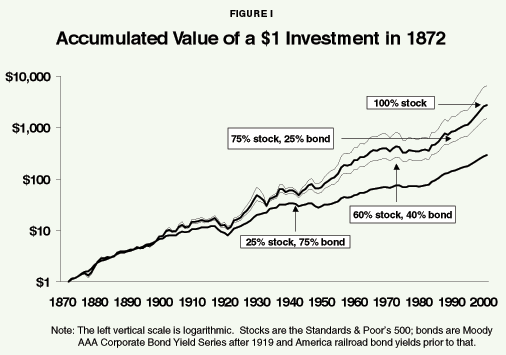
"Stocks outperform bonds and any mixed portfolio over 128 years."
Figure I shows how a single dollar invested in 1872 would grow, with the interest and dividends reinvested, if held until 2000.2 It shows the performance of an investment consisting entirely of stocks in the Standard & Poor's 500 and three mixed portfolios of S&P stocks and corporate bonds rated AAA by Moody.3 As summarized in Table I, over the entire 128-year period:
- A $1 investment in a portfolio comprised entirely of stocks would grow to $6,410.
- Invested in a portfolio comprised of 75 percent stocks and 25 percent bonds, the $1 would grow to $2,706.
- A 60 percent stock and 40 percent bond portfolio would grow to $1,484.
- A portfolio weighted with 75 percent bonds would grow to $289.
Clearly, stocks far outperform bonds and any mixed portfolio of stocks and bonds over the 128-year period. Does this relationship work for shorter periods of time?
"The return on stocks varies from a worst-year drop of 35 percent to a best-year increase of 47 percent."
Return on a Stock Portfolio. Figure II compares year-by-year rates of return on stocks and rates of return over periods of 35 years. The lighter, jagged line shows the rate of return each year. The heavier line shows the internal rate of return over the previous 35 years. We assume an annual contribution of $1, since Social Security tax payments are also made annually rather than in one lump sum.

The annual fluctuations in stock returns between 1906 and 2000 range from a worst-year drop of 35 percent to a best-year increase of 47 percent. These wide year-to-year fluctuations fuel the concerns of those who oppose allowing workers to invest part of their Social Security tax payments in the stock market. However, as the figure also shows, a longer holding period dramatically reduces the variation in rates of return.4 Although the market is volatile on a daily or annual basis, the volatility is dramatically reduced – often to a few percentage points – over long holding periods.
- The worst 35-year period, which ended in 1921, produced an average real rate of return of 2.7 percent.
- The best period, ending in 1965, produced an average real rate of return of 9.5 percent.
- Thus the difference between the best and worst results is less than 6 percentage points.
"But over 35-year periods, the difference between the best and worst returns from stocks is less than 6 percentage points."
Return on a Bond Portfolio. The annual fluctuations in a 100 percent bond portfolio are less dramatic than those of stocks, but returns still range from a one-year low of -10.8 percent to a one-year high of 18.4 percent. As was the case with the stock portfolio, the rates of return over 35-year periods are much more stable, as Figure III shows.
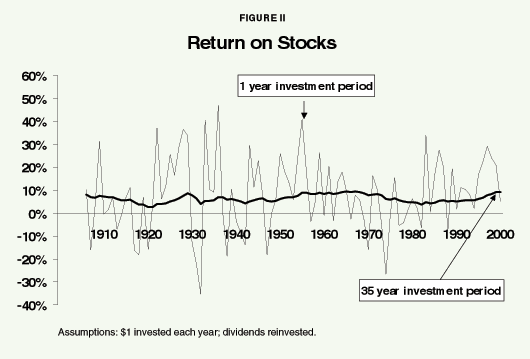
- The worst average real return from a 35-year bond portfolio investment was 0.6 percent for the period ending in 1920.
- The best return, for the period ending in 1906, was 5.1 percent.
- The difference between the best and worst return is less than 5 percentage points.
"Although there is a common perception that stocks are more risky, they outperformed bonds in every period of 20 years or more."
Return on a Mixed Portfolio. A portfolio of 60 percent stocks and 40 percent bonds is often viewed as representing the underlying mix of corporate financing instruments across all firms. Figure IV shows the yearly return and average return over the series of 35-year periods for such a portfolio, rebalanced each year to maintain the same proportion of stocks and bonds.5 Between 1906 and 2000, the annual returns ranged from a one-year low of -16.8 percent to a one-year high of 29 percent. By contrast, for 35-year periods:
- The lowest real average return, for the period ending in 1920, was 2.0 percent.
- The highest average return was 7.3 percent for the period ending in 2000.
- The average for all 35-year periods was 5.1 percent.
"Although there is a common perception that stocks are more risky, they outperformed bonds in every period of 20 years or more."
Comparison of Portfolios. Another way to evaluate the relative performance of stocks and bonds is to calculate how often a portfolio comprised exclusively of stocks outperforms a 100 percent bond portfolio. Economist Jeremy Siegel points out that for the period 1871 to 1996, stocks outperformed bonds 59.5 percent of the time over a one-year holding period, but when the holding period was 10 years, stocks outperformed bonds 82.1 percent of the time, and when the holding period was 30 years, stocks always outperformed bonds.6
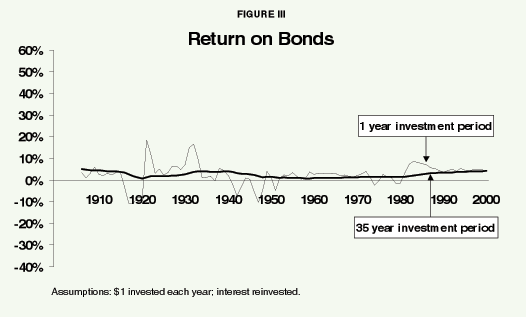
Table II summarizes the internal rates of return distributions for portfolios, with varying mixes of stocks and bonds, held for varying lengths of time during the 1872 to 2000 era. As the table shows, when the holding period lengthens, average returns decline, but so does the volatility of the portfolio.7 The table also shows how the average minimum return rises along with an increase in the share of stocks in the portfolio when the holding period is 20 or more years.
- Although there is a common perception that stocks are more risky than bonds, stocks outperformed bonds in every one of the 95 periods.
- In addition, all-stock portfolios almost always outperformed mixed portfolios containing both stocks and bonds.
"Bond portfolios and mixed portfolios are also more stable over long periods of time."
Furthermore, the performance of the capital markets is much better than what the young today can expect on their Social Security payroll tax dollars.
- The average annual real rate of return for an all-stock portfolio was 6.4 percent over the 95 periods, with the lowest being 2.7 percent for the period ending in 1921.
- A portfolio of 60 percent stocks and 40 percent bonds produced an average annual real rate of return of 5.1 percent, with the lowest being 2.0 percent for the period ending in 1920.
- By contrast, virtually all young people entering the labor market can expect a rate of return on their Social Security taxes of less than 2 percent.
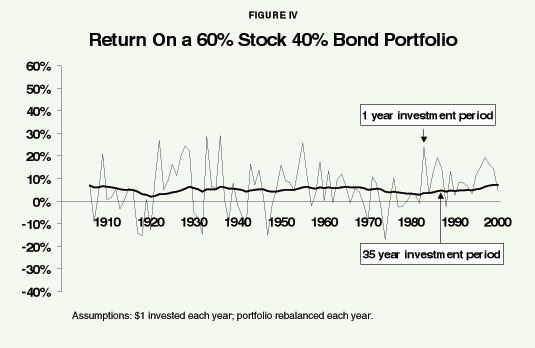
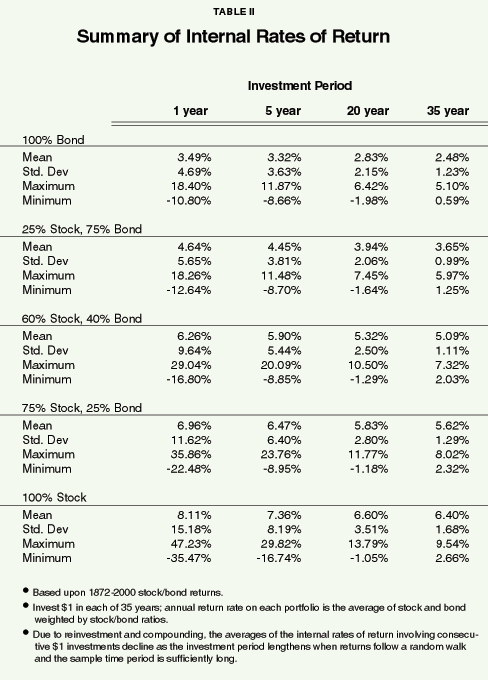
Social Security currently provides insurance against the risk of outliving one's savings. To insure against this risk, a private retirement system based on individual retirement accounts must convert the funds into annuities upon retirement. Since the purpose of personal retirement accounts is to allow workers to prepay part of their scheduled Social Security benefits, the annuity payments would offset those benefits in part. Our primary interest is in the single premium immediate annuity, which provides a fixed monthly income for the life of the purchaser.
"A private retirement system must convert individual retirement accounts to annuities upon retirement."
Inefficiencies in the Annuity Market. A current disadvantage of private annuities, as opposed to Social Security, is their considerable overhead costs and inefficiency due to a lack of competition and the presence of "adverse selection" – that is, a high percentage of people who buy annuities now tend to live longer than average, which is adverse to the insurer. Economists James Poterba and Mark Warshawsky have shown that for a typical annuity today, the present value – the dollar value of expected future benefits discounted for the time one must wait to receive them – is about 85 percent of the initial premium, with the remaining 15 percent going to profits, costs of adverse selection and overhead, including administrative and marketing costs.8 This means that for every dollar one puts into the annuity market, he or she can only get back 85 cents. This low money's worth ratio – the cost compared to the present value of expected future benefits – has led some observers to conclude that the annuity market cannot be relied upon as part of a Social Security privatization plan.
However, if personal retirement accounts become a part of Social Security, it is likely that the currently underdeveloped annuity market will gain in efficiency and the costs of annuitizing retirement payouts from individual accounts will fall substantially. Adverse selection will not be a problem if everyone is required to buy an annuity. Further, overhead costs would be spread over a much larger number of accounts. Even without the impetus of personal retirement accounts, the payout value per premium dollar of annuities rose by roughly eight percentage points between 1985 and 1995, as the annuity market expanded due to an increasing number of employers switching from traditional defined benefit pension plans to defined contribution plans such as 401(k)s.9
Reasons Why the Market for Individual Life Annuities Is Small. The sales volume of single-premium immediate annuities remains small.10 Several reasons have been cited by researchers. First, the individual life annuity market is being crowded out by both Social Security and private group annuities such as corporate pension plans. Due to the inefficiencies mentioned above, the rate of return one expects from an annuity purchase is significantly lower than what the average market investment can offer. As a result, one would only want to buy a minimum annuity offering a subsistence level of benefits, but Social Security and group pensions already take care of that.
Second, there is not much wealth left for annuitization for most elderly Americans. Perhaps due to a wrong expectation of what Social Security can offer, many low- and middle- income seniors have little wealth (except housing wealth) left for annuitization, and Social Security paychecks are their primary source of income after retirement.
"The sales volume of annuities remains small, but can be expected to grow."
Third, prices of annuity products tend to be too high because of the inefficiencies associated with the market. Ironically, most of those inefficiencies come from the fact that the annuity market is currently very small. For example, overhead costs per policy are inversely related to the size of the customer pool; the smaller the pool size, the higher the price. Moreover, a very small demand often fails to provide sufficient incentives for providers to engage in fierce competition; as a result the annuity market tends to be less than competitive and annuity prices tend to be high. Most importantly, since there are relatively few buyers, all of whom voluntarily select into the market, they tend to live longer than average. Since annuity companies do not have perfect information about buyers' longevity, they must price their products according to this higher-than-average longevity. This is the adverse selection problem.
Fourth, the variety of annuity products currently available in the United States is limited. This may also be related to the small size of the market. For example, although the single-premium immediate annuities closely parallel current Social Security benefit payments, most annuities currently available in the United States are not indexed for inflation. Thus, there is limited protection against inflation risk. Additionally, few annuity companies offer significant discounts to customers with shorter life expectancy, such as individuals who can demonstrate a long-term smoking habit.
Personal Retirement Accounts and the Future of the Annuity Market. The fact that the annuity market is not heavily used for longevity insurance and retirement income today does not necessarily mean it cannot be relied on in the future as part of a new retirement system featuring personal retirement accounts. As Social Security benefits are replaced fully or partially with proceeds from personal retirement accounts, the demand for individual life annuities will increase dramatically, as will the efficiencies of the annuity market and the variety and quality of annuities.
With a dramatic increase in annuity demand from Social Security privatization and increased senior wealth in the form of tax-deferred retirement accounts in the future, annuity company overhead is expected to fall on a per policy basis. Competition among annuity providers will increase and, as has happened in the United Kingdom since its public pension system was partially prefunded with personal retirement accounts, annuities with inflation-indexed payments will eventually be available.
Most importantly, the cost of adverse selection will be lowered significantly. Economist Olivia Mitchell and her colleagues have found that about two-thirds of the disparity between an annuity premium and its money's worth in terms of the expected present value of its future payouts can be explained by adverse selection.11 With mandatory and increased voluntary enrollments into annuity policies, the money's worth ratio of annuity purchases is likely to increase from 85 percent to 90 percent, even assuming the adverse selection would only be half as important in the future as it is now. With improvement in competition and reduction in overhead expenses, it is reasonable to expect that the money's worth ratio for annuity purchases could reach 95 percent or above.
"The abilitiy of a private retirement system to provide longevity insurance hinges on the efficiency of the annuity market."
One question is whether annuities should be mandatory. Many argue that at least a portion of the balances in personal retirement accounts should be annuitized to guarantee a certain minimum level of benefits, with the rest left to individuals' decisions. The ability of a private retirement system to provide longevity insurance hinges on the efficiency of the annuity market. Without access to annuities, consumers who have arranged their after-retirement resources based on their expectations about longevity may find themselves without sufficient resources if they live longer than expected.
[page]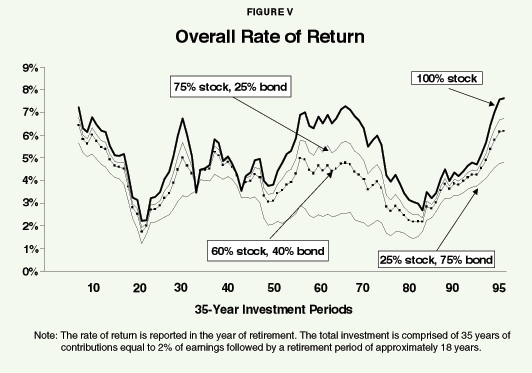
Some of the reform proposals before Congress would require that, upon retirement, the holder of a personal retirement account convert his or her account balance into an annuity yielding a fixed monthly income for life. The balance in the personal retirement account depends on the amounts deposited, the length of time it was held and the rate of return. The annuity amount that could be purchased depends on the account balance and the annuity provider's assumptions regarding the longevity of the purchaser, administrative costs for such annuities and the rate of return the provider expects to receive by investing the initial premium. Since the riskiness of personal retirement accounts depends on the volatility of the stock and bond markets, we are particularly interested in determining the degree to which annuitization affects the variation in returns retirees could expect from personal retirement accounts.
Assumptions. Most current Social Security reform proposals would allow workers to deposit part of their tax payments to personal retirement accounts. In this way workers prepay part of their currently promised benefits. A number of reform proposals call for workers to contribute 2 percent of earnings over their work lives. In this section we estimate the rates of return on a personal retirement account if an individual had invested 2 percent of earnings for 35 years, ending any year from 1906 to 2000.12 In the 35th year the investor annuitizes the entire amount he or she has accumulated.13
Qualifications. Several qualifications are in order. First, we assume annuitization of the entire balance in the account on the day of retirement.
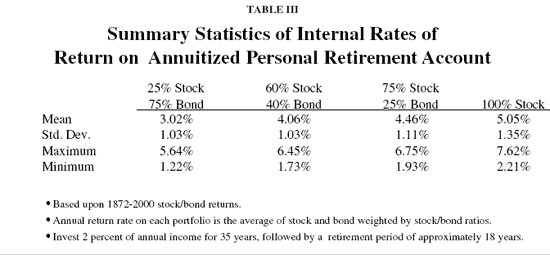
"We analyzed ninety-five 35-year periods."
A retiree would be more likely to annuitize only part of the account at retirement and the remainder later, depending on whether the market was up or down at the time of retirement. Requiring total annuitization at retirement induces more variation in returns, while allowing flexibility regarding timing would tend to smooth out fluctuations. However, here we annuitize the entire amount at retirement for consistency with Social Security and many of the proposals that include partial privatization. Second, using the corporate bond rate of return produces the most conservative set of annuity amounts. Even the portfolio with the minimum variance would not be comprised totally of bonds, but we use the bond return in consideration of annuity providers' short planning horizons and historical reliance on bonds. Third, we use mortality and life-cycle earnings data for a person born in 1960 across all time periods to restrict the variations in the rate of return from period to period to those arising from underlying market conditions, rather than any related to increasing life spans and rising real earnings.
Rates of Return. Figure V shows the rates of return at the beginning of the retirement year for each of the ninety-five 35-year investment periods. Since an annuity is based on the amount paid in and the expected life span of the retiree, these rates of return take into account 35 years of accumulation and about 18 years of payout, on the average.
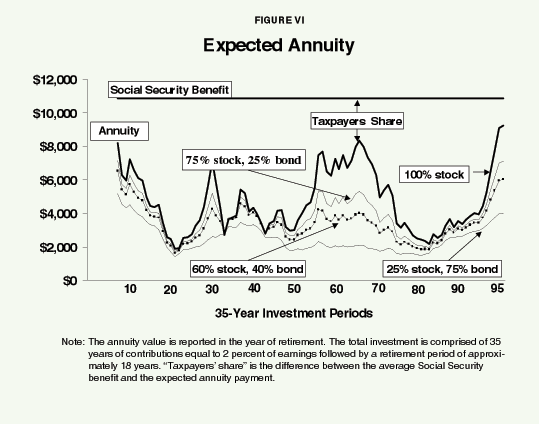
"Even the minimum rate of return on the all-stock portfolio exceeds the rate of return on Social Security taxes that young people can expect."
In all but five of the 95 periods, the 100 percent stock portfolio outperforms any other portfolio. Thus, even though there is more volatility with a 100 percent stock portfolio, it dominates the others' rates of return almost 95 percent of the time. Those retiring at the beginning of 1921 earn the lowest return, 2.2 percent, and those retiring at the beginning of 2001 earn the highest, 7.6 percent, with the 100 percent stock portfolio. Table III summarizes the series presented in Figure V. The average returns range from 3.0 percent when stocks are 25 percent of the portfolio to 5.1 percent when the portfolio is entirely stocks. Note that even the minimum rate of return on the 100 percent stock portfolio exceeds the rate of return on Social Security taxes of less than 2 percent that virtually all the young people entering the labor market can expect to receive.
Annuity Values. Figure VI presents the annuity values in each retirement year. The pattern is similar to the pattern of portfolio returns, but now the vertical axis measures the size of the annuities. Recall that the annuities purchased using the accumulated funds in workers' personal retirement accounts would be used to offset their scheduled Social Security benefits. Figure VI also illustrates how the size of an annuity component compares to Social Security benefits. In the figure the scheduled Social Security benefits are set to 42 percent of the workers' pre-retirement income, which is the long-run expectation for workers with average earnings levels.14 Since we used the same life-cycle earnings for each consecutive 35 year period, the line reflecting Social Security benefits is constant at $10,850. For illustrative purposes, the difference between the Social Security benefit and the lines reflecting the annuity values indicates the portion of each set of new retirees' benefits paid by taxpayers. But this difference is only for the new retirees in each year; averaging across all retirees in any given year, the variation in the amount taxpayers will have to pay is dampened significantly.
Note also that the accumulation phase is limited to 35 years, while the typical work life will be up to 10 years longer. With more years of investment, the annuity values would be significantly higher.

Table IV summarizes the series from Figure VI. For the 100 percent stock portfolio, the annuities averaged $4,681 based on 35 years of investing 2 percent of earnings. Individuals retiring in 1921 and investing in the 100 percent stock portfolio would have the smallest annuity, equal to $1,875. Those retiring at the beginning of this year would have the largest annuity, equal to $9,225.
"Workers who contributed 2 percent of earnings for 35 years to all-stock portfolios could expect a private annuity to equal 43 percent of currently promised benefits, on the average."
While the disparity between the largest and smallest annuities is large, the change from year to year is less so. Table V summarizes the percentage differences, year-to-year, in the value of the annuity that could be purchased from a personal retirement account. It shows that the largest percentage decrease in the value of an annuity purchased from a personal retirement account invested 100 percent in stocks would have been when the annuity value fell 38 percent – which occurred between 1932 and 1933. The largest percentage increase would have occurred in 1937, when the annuity value rose 40 percent.
Replacement Rate of Annuities for Social Security Benefits. Table VI shows the range of the share of Social Security benefits that could be paid for by annuities in varying portfolios of stocks and bonds. We estimate that if workers who contributed 2 percent of earnings for 35 years are in 100 percent stock portfolios prior to retirement:
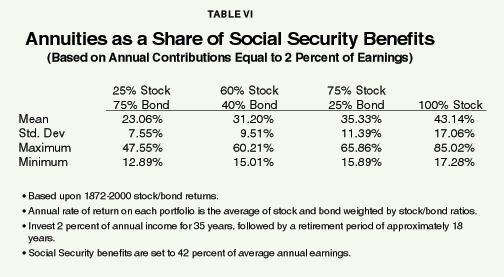
- During retirement, a private annuity would be expected to equal 43 percent of currently promised Social Security benefits.
- In the best-case scenario, the annuity would equal 85 percent of the Social Security benefit.
- In the worst-case scenario, the annuity would equal 17 percent.
"When private annuities vary in size, who bears the risk?"
How do these potential variations in the size of the annuity affect the pension benefit the retiree actually receives? This depends on the specific reform adopted. Every serious proposal limits the downside risk to the retiree. But there are differences among them. Under one proposal, for example, the annuity would offset Social Security benefits dollar for dollar. Under this plan, the retiree would not face any risk.
Under another proposal, retirees would be guaranteed a minimum benefit equal to the current system's promises. In addition, retirees would get an extra benefit equal to 25 percent of their private annuity.
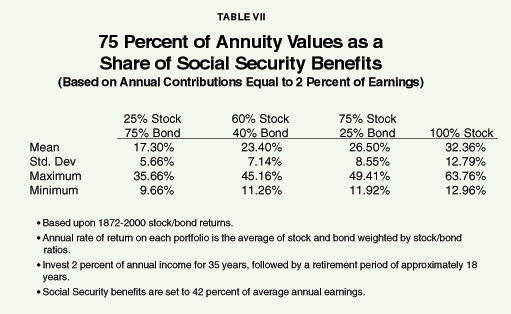
Bonuses from Annuities. A dollar-for-dollar buyout gives workers little incentive to voluntarily participate in a private account option, other than carrying with it the guarantee that they own what is in their accounts. Some, most notably economist Martin Feldstein, have suggested that workers receive a bonus related to the size of the annuity they can buy at retirement.15 Consider the average annuity of $4,681 based on the 100 percent stock investment. Retirees would receive 25 percent of this amount, or $1,170, in addition to the benefits they are now promised. This leaves 75 percent of the annuity value to defray the retirees' Social Security benefit. Table VII details the share of Social Security benefits that can be prepaid when retirees receive bonuses equal to 25 percent of their annuities' values.
"Under some proposals, the results for retirees are guaranteed."
Table VIII shows the relative size of the bonuses by portfolio. The average value of the annual bonus is $1,170 for an all-stock portfolio. So on the average total benefits are $12,020, the sum of the Social Security benefit of $10,850 and the bonus of $1,170. The maximum bonus is $2,306 and the minimum is $469. Table IX summarizes the year-to-year changes in total benefits where the total benefits are equal to the sum of Social Security benefits and the bonuses. As indicated in the table, even with bonuses, the year-to-year difference in total pension benefits for retirees with the same income would be less than 4 percent.

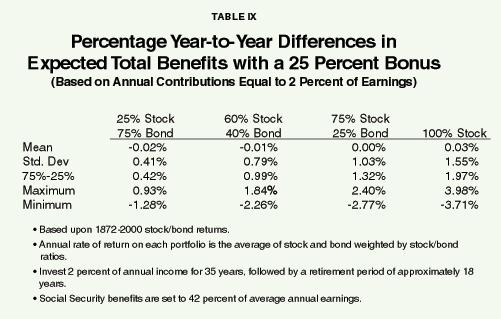
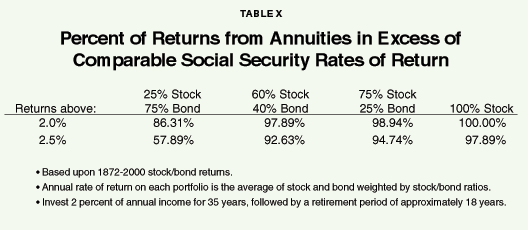
"Even with bonuses, the year-to-year difference in total pension benefits would be less than 4 percent."
As we have seen, with a 2 percent contribution rate, personal retirement accounts will not totally replace scheduled Social Security benefits and as a result, the redistributive benefit formula can remain unchanged if desired. Workers who experienced high returns on their private accounts will be able to replace more of their Social Security benefits than workers who had lower rates of returns while in the labor force. Taxpayers will be called on to make up the difference between the scheduled Social Security benefits and the amount offset by the annuitized PRAs.
But this does not mean that taxpayers will have to bail out retirement account holders on a regular basis. As long as the annuity return exceeds the rate of return on Social Security taxes paid, the personal retirement accounts have gained ground on Social Security and will result in lower future taxes than would be needed to continue to pay benefits under the current system.
We previously estimated the returns that current and future retirees can expect from Social Security taxes they have paid.16 For new entrants to the labor force, we estimated that the rate of return Social Security delivers for the typical single male worker will be 1.64 percent. The report of the 1994-1996 Advisory Council on Social Security estimates that the rate for the average single male will be 1.57 percent and for an average two-earner couple 2.15 percent.
Table X identifies the percent of returns from the personal retirement account annuities that exceed returns of 2 percent and 2.5 percent.
- The return from a 100 percent stock portfolio always exceeds 2 percent, and exceeds 2.5 percent return about 98 percent of the time.
- The return from a portfolio with at least 60 percent stock holdings exceeds 2 percent about 98 percent of the time, and exceeds 2.5 percent nearly 93 percent of the time.
"As long as Social Security offers a guaranteed benefit, taxpayers already act as the guarantors."
Of course, during the start-up phase of a transition to partially prepaid Social Security, older workers will participate for a few years and then retire. As was indicated in Table II, the shorter investment horizons may produce returns less than the Social Security return. If this occurs, assuming a policy decision to continue to insure stable Social Security benefits, taxpayers would have to make up the difference between the realized rate of return and the Social Security rate of return. Note, however, that as long as Social Security offers a guaranteed benefit, taxpayers already act as the guarantors.
[page]"In the long run, investing Social Security taxes on the financial markets involves very little risk."
Members of both political parties have come out in favor of personal retirement accounts as a means of prepaying some of Social Security's looming liabilities. A persistent criticism of such a move has been that the accounts would expose future retirees to too much investment risk. But as we have seen, this criticism is invalid for several reasons. First, the rates of return are less volatile than they are usually made out to be. Fundamentally, realized rates of returns from long-term stock market investments show less variation than annual swings. Second, using conservative assumptions about the annuitization of personal retirement account balances at retirement, we find that returns from portfolios with at least 60 percent stock holdings are higher 98 percent of the time than the return today's young workers can expect from the Social Security taxes they pay.
Finally, prepayment plans of the sort that allow workers to invest part of their payroll taxes in personal retirement accounts will partially, but not entirely, replace Social Security. With a mixed system, the redistribution inherent in the benefit formula may be maintained if desired, and taxpayers can continue to serve as the insurer of last resort, paying the portion of scheduled benefits that are not paid for by the personal retirement account annuities.
NOTE: Nothing written here should be construed as necessarily reflecting the views of the National Center for Policy Analysis or as an attempt to aid or hinder the passage of any bill before Congress.
[page]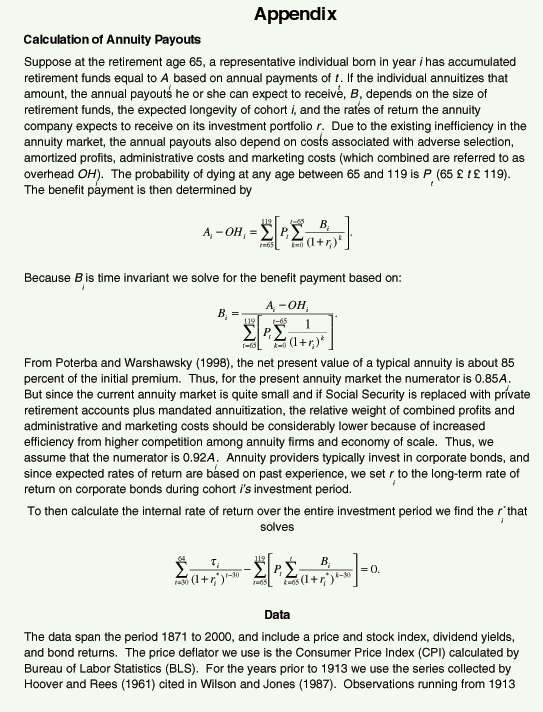
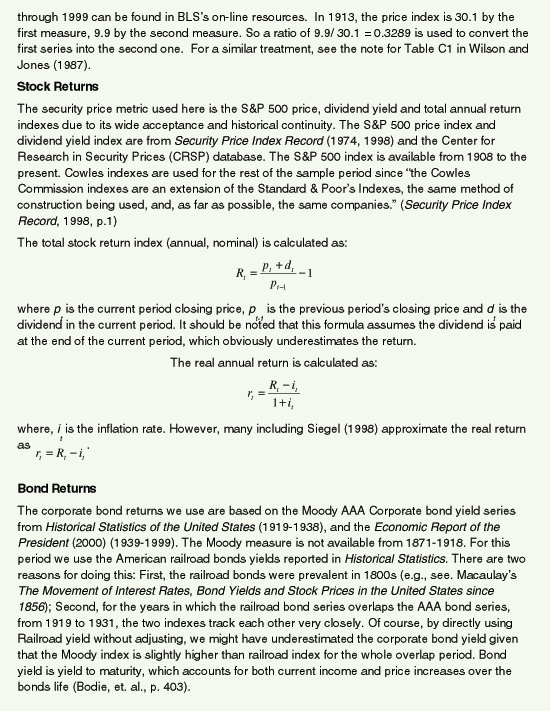
Felicitie C. Bell, Alice H. Wade and Stephen C. Goss, "Life Tables for the United States Social Security Area 1900-2080," Actuarial Study No. 107, U.S. Department of Health and Human Services, Social Security Administration, Office of the Actuary, August 1992.
Zvi Bodie, Alex Kane and Alan J. Marcus, Investments, 3rd ed. (New York: Irwin, 1996).
Bureau of Labor Statistics, "Consumer Price Index," accessed on-line, September 9, 2000. ftp://ftp.bls.gov/pub/special.requests/cpi/cpiai.txt
Economic Report of the President, 2000 (Washington D.C.: U.S. Government Printing Office, 2000).
Alfred Cowles 3rd and Associates, Common-Stock Indexes 1871-1937 (Bloomington, Ind.: Principal Press, Inc., 1938).
Martin Feldstein, "Social Security Reform: America's Golden Opportunity," Economist, March 13, 1999.
Sidney Homer A History of Interest Rates, 2nd ed., (New Brunswick, N.J.: Rutgers University Press, 1977).
Roger G. Ibbotson and Gary P. Briston, Investment Markets (New York: McGraw-Hill Book Company, 1987).
Liqun Liu and Andrew J. Rettenmaier, "The Attractiveness of the Social Security Investment for Members of Different Racial and Education Groups,: Private Enterprise Research Center, PERC Working Paper #0010, November 2000.
Frederick R. MaCaulay, "The Movements of Interest Rates, Bond Yields and Stock Prices in the United States since 1856," National Bureau of Economic Research, New York, 1938.
Olivia S. Mitchell, James M. Poterba, Mark J. Warshawsky and Jeffrey R. Brown, "New Evidence on the Money's Worth of Individual Annuities," American Economic Review, 89: 1299-1318, 1999.
James M. Poterba and Mark J. Warshawsky, "The Costs of Annuitizing Retirement Payouts from Individual Accounts," in J. Shoven, ed., Administrative Costs and Social Security Privatization (Chicago: University of Chicago Press, 2000).
Andrew J. Rettenmaier and Thomas R. Saving, The Economics of Medicare Reform (Kalamazoo, Mich.: W. E. Upjohn Institute for Employment Research, 2000).
Jeremy J. Siegel, "The real rate of interest from 1800-1990," Journal of Monetary Economics 29, 227-252, 1992.
Jeremy J. Siegel, Stocks for the Long Run, 2nd ed. (New York: McGraw-Hill, 1998.)
Standard & Poor's Statistical Service: Security Price Index Record, 1974, 1998 eds.
The Board of Trustees, 2001 Annual Report of the Board of Trustees of the Federal Old- Age and Survivors Insurance and Disability Insurance Trust Funds, Social Security Administration, 2001.
U.S. Bureau of the Census, Historical Statistics of the United States, Colonial Time to 1957, Washington, D.C, 1960.
U.S. Department of Commerce, Bureau of Census, Statistical Abstract of the United States, various issues.
Jack W. Wilson and Charles P. Jones, "A comparison of annual common stock returns: 1871-1925 with 1926-85," Journal of Business 60, 239-258, 1987.
[page]- This paper's stock analysis is based on the performance of the Standard & Poor's 500 and the bond analysis is based on the Moody AAA Corporate Bond yield series after 1919 and American railroad bond yields prior to that. See the appendix for details.
- All data series begin in 1871, including the price index. Thus the first annual inflation rate is the 1871 to 1872 change. As a result the data series for the real rates of returns on stocks and bonds begin in 1872.
- Although interest on bonds would also be reinvested, because of differences in the rate of return between stocks and bonds the mixed portfolios would have to be "rebalanced" annually – with, for example, some of the stock dividends going to purchase additional bonds to keep the same percentage of dollars invested in each. Returns from a bond-only portfolio are not considered because, as shown later, even a minimum-risk portfolio would include some stocks.
- The rates of return for the 35-year investment periods are the internal rates of return from annual $1 investments. The annual investments are used rather than a single investment to emulate Social Security tax payments. We limit the comparison to 1906 to 2000 because the first completed 35-year holding period begins in 1872 and ends at the end of 1906.
- The rate of return on a mixed portfolio assumes that investors myopically rebalance their portfolio in each year to maintain the equity and bond shares.
- Jeremy J. Siegel, Stocks for the Long Run, 2nd ed. (New York: McGraw-Hill, 1998).
- Moving down the table from lower to higher stock holdings, the average returns rise but the measures of dispersion actually decline and then rise again. This is as expected from portfolio theory; namely, the portfolio with the minimum risk is some combination of stocks and bonds. Over a 35-year period, and for an investment of the sort we consider involving annual contributions, stocks would comprise 37.1 percent of the minimum risk portfolio – the portfolio with the minimum standard deviation from the mean. For shorter investment horizons the share of stocks in the minimum risk portfolio declines – down to 3.7 percent for one-year investments. The minimum risk portfolio does not represent the optimal holding of stocks and bonds for all investors, however. That optimal holding is determined by the investor's willingness to trade between higher returns and additional risk.
- James M. Poterba and Mark J. Warshawsky, "The Costs of Annuitizing Retirement Payouts from Individual Accounts," in J. Shoven, ed., Administrative Costs and Social Security Privatization(Chicago: University of Chicago Press, 2000).
- See Olivia S. Mitchell et al., "New Evidence on the Money's Worth of Individual Annuities," American Economic Review, No. 89, 1999, p. 1311.
- Ibid.
- Ibid.
- To keep the exercise simple, we use the same annual earnings profile for each period considered – what a person born in 1960 is expected to earn each year between the ages of 31 and 65, based on both historical data and projected earnings. The projections are based on the methodology described in Andrew J. Rettenmaier and Thomas R. Saving, The Economics of Medicare Reform (Kalamazoo, Mich.: W. E. Upjohn Institute for Employment Research, 2000).
- The rate of return used to calculate the annuity amount that could be purchased with the individual's retirement account balance is set to the average rate of return earned on AAA corporate bonds over the investment period. Also, we assume that the annuity provider requires an amount equal to 8 percent of the cumulative value of the annuity to cover administrative costs. We calculate the annuity amount using the unisex mortality experience of individuals born in 1960, assuming they live to the age of 65. The probability of dying at each age between 65 and 119 is used to weight the annuity payments up to the year of death. The annuity formula is in the appendix. The mortality data are from Felicitie C. Bell et al., "Life Tables for the United States Social Security Area 1900-2080," Actuarial Study No. 107, U.S. Department of Health and Human Services, Social Security Administration, Office of the Actuary, August 1992. In other words, we use the same life-cycle deposits to the accounts and the same longevity experience for each consecutive 35-year period, so that the rates of return for all the periods can be compared.
- See Table III.B5, in the 2000 Trustees Report.
- Martin Feldstein, "Social Security Reform: America's Golden Opportunity," Economist, March 13, 1999.
- Liqun Liu and Andrew J. Rettenmaier, "The Attractiveness of the Social Security Investment for Members of Different Racial and Education Groups," Private Enterprise Research Center, PERC Working Paper #0010, November 2000.
Dr. Liqun Liu is an Assistant Research Scientist at the Private Enterprise Research Center. His primary research areas are taxation analysis and evaluation of government expenditures. His current focus is on the effects of reforming elderly entitlements. Dr. Liu serves as an investigator on several research grants. He has papers published in National Tax Journal, Economic Inquiry, Journal of Institutional and Theoretical Economics, and Review of Economic Design.
Dr. Andrew J. Rettenmaier is the Executive Associate Director at the Private Enterprise Research Center at Texas A&M University. His primary research areas are labor economics and public policy economics with an emphasis on Medicare and Social Security. Dr. Rettenmaier and the Center's Director, Thomas R. Saving, have presented their Medicare Reform proposal to U.S. Senate Subcommittees and to the National Bipartisan Commission on the Future of Medicare. Their proposal has also been featured in the Wall Street Journal, New England Journal of Medicine, Houston Chronicle and Dallas Morning News. Dr. Rettenmaier is the co-principal investigator on several research grants and also serves as the editor of the Center's two newsletters, PERCspectives on POLICY and PERCspectives. He is co-author of a book on Medicare, The Economics of Medicare Reform (Kalamazoo, Mich.: W. E. Upjohn Institute for Employment Research, 2000), and is an editor of Medicare Reform: Issues and Answers, the University of Chicago Press (1999).
Dr. Zijun Wang is an Assistant Research Scientist of the Private Enterprise Research Center at Texas A&M University. His primary research interests are econometric forecasting, empirical consumption analysis and health economics. Dr. Wang has published in the Journal of Forecasting and has presented his research on stock market volatility at an international conference. He has served as a referee for Economic Inquiry. Before coming to the United States Dr. Wang published several papers on the Chinese economy, and is the co-author of Road Toward Market Economy, Xinhua Press House, Beijing, 1993. Dr. Wang has worked extensively on Medicare and Social Security research since he joined the Private Enterprise Research Center.